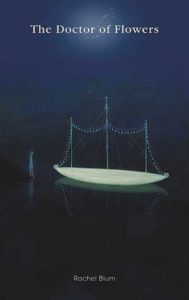The Doctor of Flowers
Reviewed by Bob Dixon-Kolar
August 1, 2019
By Rachel Blum. 3: A Taos Press, 2018. 99 pages. $24/paperback.
In her splendid poetry collection The Doctor of Flowers, author Rachel Blum recounts a memory: she and her two daughters are attending a worship service. Michaela, her younger daughter, sits beside her, holding her mother’s hand. Her other daughter Isabel is present, too—in spirit, “a cloud of light.” Isabel died of an illness ten years earlier at the age of ten.
In temple
between my daughters,
one passed
ten years now,
so one in form
and one a cloud of light
reaching for my hand, . . .while the other
takes my hand
in hers, as if she feels
her sister near
As I relish and contemplate Blum’s elegiac poetry, I keep thinking of William Penn’s consoling words: “Death is but crossing the world, as friends do the seas; they live in one another still.” Parents very much understand this: our children are of our essence. Blum says of her daughters:
Two parts/of the one body—
mine—
soul hopes—
one here
and one there
In another poem, she recalls weekly trips with Isabel to the oncology clinic:
In the panic and grace of those afternoons, it was as if we would last—your soul had turned down this road, and I would be with you. And it was as if we’d died. Our bodies already thinned to light, and still I was with you.
The Doctor of Flowers begins and ends with intimate poems addressed to Isabel. The main body of the book is divided into five sections, each containing a set of lush and allusive poems. Woven throughout are biographical passages that narrate the onset and course of Isabel’s illness and her transition from earthly life into a spiritualized existence. In her poetry, Blum lays bare her sadness and her efforts to fathom and transform her private grief—and, despite all, “to love everything.”
Her poetry also honors her personal relationships and the diverse religious traditions that have shaped her. A few poems commemorate occasions, such as the Jewish holidays of Rosh Hashanah and Yom Kippur, and the birthday of Sufi mystic and poet Jalāl al-Dīn Muhammad Rumi. Other poems are dedicated to Isabel, Michaela, and other family members and friends. One lovely poem in section 3 is a poem of blessing to Michaela. Its form is reminiscent of the well-known Apache blessing, in which each stanza leads off with the words “May the . . .”
Blum’s images are simultaneously descriptive and symbolic, and they often combine or transfigure in surprising ways. In one poem, autumn leaves that scatter and catch light are described as “illuminated leaves,” bringing to mind an illuminated medieval manuscript whose “leaves” (pages) were decorated by monks. As the poem continues, this symbolic image suddenly broadens out and becomes mysterious, portentous: “a child is offered to a monastery / to birth her perfect longing.” In the poetic world of The Doctor of Flowers, nature speaks in lost sacred languages: “Letters forgotten / like tablets on a wheel.”
Evocative images abound in The Doctor of Flowers. I have space only to name a few: ships gliding through dark water or soaring in deep space; galloping horses; tender, maternal hands (“I remember you best with my hands,” writes Blum in two different poems); caring, spiritually sensitive children; overshadowing trees, climbing plants, and blooming flowers.
There are all manner of flowers: phantom roses, a calla lily, print flowers on a housecoat, sky-reaching flowers drawn by little girls. “Coming back,” writes the poet, “is the law of the garden.”
Pulsing through Blum’s poetry are the cycles of life, death, and renewal. Consider one example:
In the market
weeks before her death,
Isabel held out a pomegranate
and remarked on Persephone’sgood fortune of reunion.
In the Greek myth, Persephone is fated to live in the underworld, for the offense of eating a few pomegranate seeds. However, during the growing time of each year, she is permitted to reunite with her grieving mother Demeter, goddess of fertility and seasonal cycles. Blum takes her sorrowful experience of loss, which could have led her toward isolation and withdrawal, and translates it into larger natural rhythms and an archetypal story of revival, love, and communion.
We can learn from participating in Blum’s poetic imagination. She is—more than most of us ordinarily are—attuned to the significance of intimations and synchronicities, of everyday angelic messengers, of dream deliverances and visitations, and of waking visions.
Rachel Blum was raised and educated within Quaker communities. She attended Germantown Friends School and graduated from Haverford College. In 2018 she did a public reading from her book at Chestnut Hill Meetinghouse in Philadelphia. I believe that Friends who dwell within The Doctor of Flowers will sense her commitment to peace and compassion and her receptivity to the Divine Light, in all its brilliant, refracted, and many-colored forms.




Comments on Friendsjournal.org may be used in the Forum of the print magazine and may be edited for length and clarity.